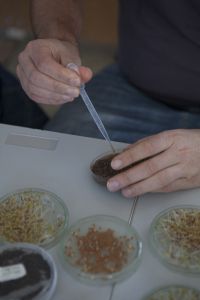| Line 34: | Line 34: | ||
==Basic concepts== | ==Basic concepts== | ||
===Life=== | ===Life=== | ||
"There are over a 100 definitions for 'life' and all are wrong" | "There are over a 100 definitions for 'life' and all are wrong" <br> | ||
http://www.bbc.com/earth/story/20170101-there-are-over-100-definitions-for-life-and-all-are-wrong | http://www.bbc.com/earth/story/20170101-there-are-over-100-definitions-for-life-and-all-are-wrong | ||
===Organism=== | ===Organism=== | ||
https://en.wikipedia.org/wiki/Organism | https://en.wikipedia.org/wiki/Organism | ||
In biology, an organism (from Greek: ὀργανισμός, organismos) is any individual entity that exhibits the properties of life. It is a synonym for "life form". | In biology, an organism (from Greek: ὀργανισμός, organismos) is any individual entity that exhibits the properties of life. It is a synonym for "life form". | ||
Organisms are classified by taxonomy into specified groups such as the multicellular animals, plants, and fungi; or unicellular microorganisms such as a protists, bacteria, and archaea. All types of organisms are capable of reproduction, growth and development, maintenance, and some degree of response to stimuli. | Organisms are classified by taxonomy into specified groups such as the multicellular animals, plants, and fungi; or unicellular microorganisms such as a protists, bacteria, and archaea. All types of organisms are capable of reproduction, growth and development, maintenance, and some degree of response to stimuli. | ||
| Line 49: | Line 47: | ||
====Eukaryote==== | ====Eukaryote==== | ||
Eukaryotic organisms are characterized by the presence of a membrane-bound cell nucleus and contain additional membrane-bound compartments called organelles (such as mitochondria in animals and plants and plastids in plants and algae, all generally considered to be derived from endosymbiotic bacteria). Fungi, animals and plants are examples of kingdoms of organisms within the eukaryotes. | Eukaryotic organisms are characterized by the presence of a membrane-bound cell nucleus and contain additional membrane-bound compartments called organelles (such as mitochondria in animals and plants and plastids in plants and algae, all generally considered to be derived from endosymbiotic bacteria). Fungi, animals and plants are examples of kingdoms of organisms within the eukaryotes. | ||
==Suggested resources regarding the proposed projects/topics== | ==Suggested resources regarding the proposed projects/topics== | ||
Revision as of 23:07, 2 November 2018
Modul #1 – Introduction to Experimental Microbiology
Lecturer: Julian Chollet
Credits: 6 ECTS, 4 SWS
Date: 09.-11. November 2018 (09:00 – 17:00)
Venue: Marienstraße 7b, DIY BioLab (Room 202)
Syllabus
This 3 day intensive course builds upon the practical skills acquired in the module “DIY Bio: doing things with biology” (by Mindaugas Gapsevicius) and aims to introduce you to the methodologies, project planning and experimental strategies in the natural sciences. While working in the DIY BioLab (Chair of Media Environments) you will learn how to think like a microbiologist and what it means to do scientific research. Educational objectives include literature research, experiment design, result documentation, discussion and scientific writing.
The course will be structured in a flexible way, tailored to the needs of the participants and the program will be developed collaboratively. Attendance during the 3 days of the course, as well as the delivery of detailed project documentation (paper, artwork, etc.) until the end of the semester is required. For students without prior experience in biological research this module is a requirement for attending the module “Artistic research in Experimental Biology” (11. - 13. January 2019).
Students
Basic concepts
Life
"There are over a 100 definitions for 'life' and all are wrong"
http://www.bbc.com/earth/story/20170101-there-are-over-100-definitions-for-life-and-all-are-wrong
Organism
https://en.wikipedia.org/wiki/Organism In biology, an organism (from Greek: ὀργανισμός, organismos) is any individual entity that exhibits the properties of life. It is a synonym for "life form". Organisms are classified by taxonomy into specified groups such as the multicellular animals, plants, and fungi; or unicellular microorganisms such as a protists, bacteria, and archaea. All types of organisms are capable of reproduction, growth and development, maintenance, and some degree of response to stimuli.
Prokaryote
Prokaryotes are represented by two separate domains—bacteria and archaea. A unicellular organism that lacks a membrane-bound nucleus, mitochondria, or any other membrane-bound organelle.
Eukaryote
Eukaryotic organisms are characterized by the presence of a membrane-bound cell nucleus and contain additional membrane-bound compartments called organelles (such as mitochondria in animals and plants and plastids in plants and algae, all generally considered to be derived from endosymbiotic bacteria). Fungi, animals and plants are examples of kingdoms of organisms within the eukaryotes.
Suggested resources regarding the proposed projects/topics
Cytoplasmic streaming
- https://en.wikipedia.org/wiki/Cytoplasmic_streaming
- https://en.wikipedia.org/wiki/Physarum_polycephalum
- https://www.youtube.com/watch?v=9uPsOVrDM-8
- https://www.youtube.com/watch?v=KZ_ocrDNABQ
Superabsorber & Microplastics
- https://en.wikipedia.org/wiki/Superabsorbent_polymer
- https://en.wikipedia.org/wiki/Sodium_polyacrylate
Bioluminescence
- https://hackteria.org/wiki/Explorations_in_BioLuminescence
- https://www.instructables.com/id/Bioluminescent-Bacterial-Lightbulb-Water-Polluti/
Sonification of microbial activity
Projects
if you already have an idea, please describe it here!!
Related Projects from the DIY Biolab @Bauhaus
please add projects!! :)
